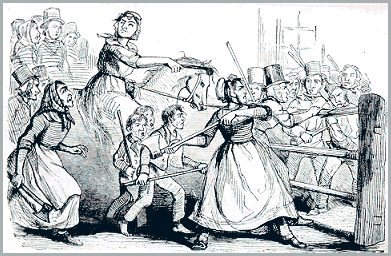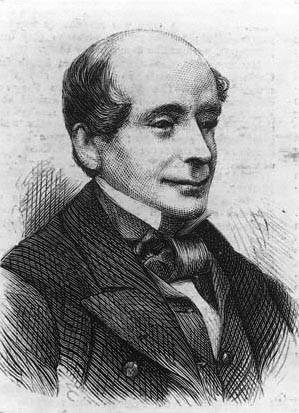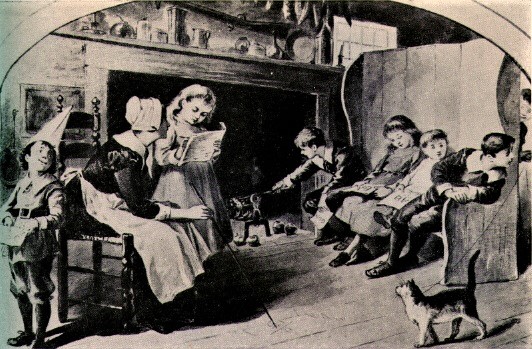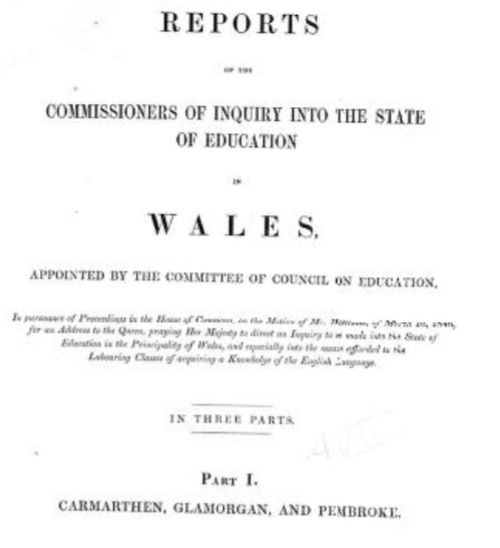THE ‘TREASON OF THE BLUE BOOKS’ AS THEY RELATE TO PEMBREY AND BURRY PORT

In 1844 in South Wales 45% of married men and 70% of married women were unable to write their own names, according to a government report. This is one indication of the poor state of education in the country at this time. In the same year the commissioners of the enquiry into the Rebecca Riots had suggested that the disturbances were partly due to the lack of educational facilities and in particular to the ignorance of the English language which they saw as a serious impediment to any general improvement. Lack of spoken English was regarded as a serious handicap to workers’ involvement in society, career advancement or change of occupation.
Many people in Wales would have agreed that they needed English to get on in the wider world and Rev. David Rees of Llanelli, editor of Y Diwygiwr, reflected this view when he wrote that “we should be ready to welcome the spread of English…however much we may regret the passing of the sonorous and adequate old Welsh language…”. It was a Welshman, William Williams, born in Carmarthenshire who raised the issue of education in Wales in the House of Commons in 1846 and argued that the government should set up a state system of elementary education in Wales following an enquiry into the state of education in Wales. ‘Law and order’ could be improved by education.

It was James Kay-Shuttlesworth who appointed the three commissioners for the enquiry and gave them their instructions. None of the three had any educational experience or knowledge of the Welsh language, and they appointed assistants to help them. In Carmarthenshire the Commissioner, Ralph Lingen, a classical scholar and barrister, was assisted by a nonconformist from Merthyr and two Anglican students from Lampeter.
The instructions to the commissioners included identifying the existing number of schools for the education of the children of the labouring classes or adults, attendance, the ages of the scholars, the character of the instruction, condition of the school, the language of instruction etc. But the offence to the people of Wales was mainly caused by the requirement to report on the character of the people and how an improved education system might be influential on ‘the general condition of society and its moral and religious progress’.
The report is hundreds of pages long, a tedious and repetitive read at times but an invaluable glimpse into society at the time. It is scathing in its attack on the state of education in Wales; the tone was often derisory and the approach lacking in empathy. It portrayed an insufficient number of schools, inadequately trained teachers and too few children attending school and with irregular attendance. The reason for the latter was often the inability to pay the school pence and family responsibilities. The teaching of English, the medium of instruction in most schools, was poor. Most children had no knowledge of English and often neither did the teachers. Others used English text books which the children could not read.
The commissioners did praise a number of features.
- The Sunday schools enabled people to gather as equals, providing worship, some discussion and instruction and in which some displayed leaderships skills. Although regarded as ‘real fields of mental activity’ they were seen as limited largely to reading the scriptures in a repetitive way and moral and religious instruction. They were never a substitute for the day school, although they were recognised as the major force for literacy in the Welsh language. Often the behaviour of the children was disruptive. The church Sunday schools (as opposed to the chapel), however, were quite different, often led by clergy and with more competent teachers.
- Accommodation for schools was generally poor but there are a few good ones of ‘a scholastic appearance’. For example, in the parish of Llanybydder Colonel Wood’s school had a triple tier of benches one side, desks the other, a teacher’s desk and fireplace. Although the room had walls of rough-hewn stone there was nothing of the ‘untidiness and squalor’ described. Arithmetic, spelling and geography was taught from a large slate and there were maps and coloured prints on the wall.
- The learning ability of the Welsh people was often commended (what they called ‘the native intelligence’) in that they were able ‘to learn well that which was taught badly’. With regard to the Bible, their reading and skill in discussing it theologically was superior to their English counterparts. Yet mental activity was restricted largely to theological ideas.
The Commissioners criticised a range of aspects of education and behaviour.

- The Welsh language was identified early in the report as an issue: “My district exhibits the phenomenon of a peculiar language isolating the mass from the upper portion of society”. It was described as “a language of the old-fashioned agriculture, of theology, and of simple rustic life” which stopped a Welsh man from getting to the top of the social scale (‘keeps him under the hatches’) or entering the office since he lacked the ability to communicate in a world of English and is isolated within his narrow sphere of activity from other influences. Yet they recognised that parents wanted their children to learn English although Welsh was the language of their life.
- Among the agricultural and manufacturing quarters there was little evidence of a sound education. Most farmers could write little more than their names, were not much better educated than their labourers and struggled to keep efficiently their accounts.
- The number of buildings used for schools In Carmarthenshire which were in bad repair was around 36%. To give an example, one school was held in a part of the dwelling house and scholars reached it by means of a ladder through a hole in the loft. The room was lit by one small glazed window half of which was patched up with boards. The furniture consisted of one table, and a few broken benches. There were several large holes in the floor. The room was dark. Indeed, just over 10% of school buildings were legally secured for educational purposes and a school might be in the teacher’s home, the kitchen of a farmhouse, an adjacent outbuilding, a loft, the church or chapel itself.
- The average age of teachers was 40 years and only about 12% were trained. They came from a wide variety of previous occupations including school assistants, commercial clerks, carpenters, milliners, domestic servants, farmers, mariners, married women, ministers. They were held in low esteem. In one school it was recorded that “the schoolmaster unites with his educational duties the somewhat anomalous functions of barber and layer out of the dead”. There was a large number of ‘private adventure’ schools, mostly of extremely poor standard, since anyone could open a school irrespective of experience.
- One of the problems identified in country schools was the lack of uniformity of books and alsoof apparatus. Bibles provided some consistency but each child would bring to school a different book for learning to read. This was not the case in the work schools. In some schools extra payment was required for the teaching of writing and arithmetic and most of the time other subjects such as history and geography would not be available.
- Ventilation was a problem and inspectors complained about hot sickening smells in rooms with up to 50 children huddled together. They described “squalid and miserable hovels” and it was not uncommon for children to kneel on a floor of bare earth writing on an old door laid upon on benches. Conversely, some schools were cold, drafty and with thatched, leaking roofs. The majority of places used for a school had no toilet facilities.
- Poverty was the main reason preventing the labouring classes from attending school. Wages were low and it was a struggle for parents to provide a good diet. Not only was attendance irregular and neither was it accurately recorded. Difficulty in communicating by road in the winter was an issue, but the commissioners also noted the holding of an undue number of fairs takes place “at which drinking is practised no less than buying and selling”. In one village of 1700 people there were 47 public houses and nine fairs held in the course of the year. Poverty was also the reason for the observation that “in their habits the labouring classes are particularly dirty” with animals allowed in the houses and lack of toilets.
- It was in fact the comments in the Blue Books on the people’s behaviour that caused the most offence. There were claims of ‘immorality’ between the sexes, chiefly among farm servants who had to share accommodation at night. Unmarried servants were known to ‘”range the country at night” and were admitted into houses by the servants or met up at the public houses. Even the nightly prayer meetings at the chapels were claimed to be places where lovers met up and the “Welsh peasant girl is almost universally unchaste”.
- Men were criticised for indecency in washing naked before the women and women for changing their undergarments before the men. Both were criticised for sleeping in the same room, whether married or single. Those comments referring to Llanelli and Pembrey paint an improved picture with drunkenness the main problem. Ironically, the observations provided for the commissioners by Llanelli industrialists Richard Nevill and William Chambers Junior are the most devastating. They complained of the Llanelli people’s “disregard of truth and the laxity of morals”, a lack of parental responsibility and wives are “mostly slovenly and improvident, and as mothers ignorant and injudicious”.
Pembrey Schools
There are three Pembrey Parish day schools mentioned in the report, visited on February 10th and 11th 1847 by the inspecting assistant William Brown. The Sunday Schools are listed with the information in columns.

1. Trim Saron, 1843. This was a National School (i.e. linked to the Anglican National Society) but supported mainly by the iron masters Messrs. Norton, Upperton and Stone who pay four shillings a week to the mistress for teaching their workmen’s children. The children are required also to pay 1d per week, but it seems not all managed to do that. Farmers’ children pay 2d a week. The mistress was said to speak English “tolerably well”. The furniture consisted of one table, one desk, and four benches. Some of the copy books were “tolerably well written”. Plans were mentioned of a new school to replace the small building for 40 pupils and Norton and Stone had pledged £100 towards it.
2. Furnace school, 1845. A private adventure school, it is more often referred to as ‘Stanley’s School’ after the mine owner, John Stanley. The report states that the master was a clergyman’s son and had received a good education. The scholars were the children of farmers and labourers, but on the day visited there were very few children present because of the snow. “The copy books were kept very clean and were well written”.
3. Richard Hall’s school, 1834. A private adventure school, the master of the school is described as “an illiterate man” and the scholars were principally labourers’ children.
Nine Sunday Schools are listed and those with the highest number of children attending were Rehoboth, Pembrey (110), Bethel, Pembrey (97), Pwll Baptist (92) and Jerusalem, Burry Port (76). The others listed were Ebenezer (Hermon); the Church Vestry Room Pembrey; Gwscwm (Tabernacle); Pencaerdrysi Pinged; Sardis Trimsaran. In most of them the teaching was in English and Welsh and generally at least a third of the pupils were described as being able to read. Bibles and ‘elementary books’ were used for reading.
Conclusions
The report came to be known as the ‘Treason of the Blue Books’ from the colour of its cover, and because it caused a furore especially with regard to derogatory comments made about the behaviour and morals of the Welsh people.
Although they worked incredibly hard, covered a huge number of day and Sunday schools and the information they provided is very detailed, the commissioners and their assistants have been regarded as unqualified for the job. Their background and upbringing did not give them any understanding of the communities they were investigating.
Another point of criticism was that four out of five of the inspectors were Churchmen in a country that was primarily Nonconformist. The commissioners were regarded as having overemphasised and exaggerated a dark side to Welsh life and it was claimed that it was often a case of Anglican clergyman painting an unfavourable picture of the activities among the Nonconformists, whom they regarded as their opposition.
It was pointed out that the team had no experience of examining schools nor any conception of what could be reasonably taught in an elementary school. Furthermore, the approach was inappropriate and the questions asked were misleading. For example, ‘Peter was one of the prophets, was he not?’
In truth, the educational situation was extremely poor, but no poorer than many areas in England. The commissioners in fact recognised the hunger that the Welsh had for education and especially praised the work of the Sunday Schools. What the grim report did was to dramatically raise awareness of the dire state of education in Wales and the inadequacy of the teaching and stir into action the Societies responsible for the provision of education. But at the same time it hardened attitudes toward Anglicanism and increased the competition between the two societies supporting Anglicanism and Nonconformism. The need was recognised for the intervention of the state but this came slowly and by the time of the 1870 Education Act government grants to school provided for only 60% of the pupil places needed.
Sources
1. Reports of the Commissioners of Inquiry into the State of Education in Wales, Vol 1, 1847, National Library of Wales.
2. Frank Price Jones, ‘The Blue Books of 1847’ in The History of Education in Wales, Ed. Jac L.Williams and Gwilym Rees Hughes, Vol. 1, Christopher Davies Pubs, Swansea, 1978.
3. A History of Education in Wales, Gareth Elwyn Jones and Gordon Wynne Roderick, University of Wales Press, 2003.
GRAHAM DAVIES October 2021
